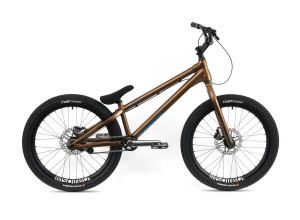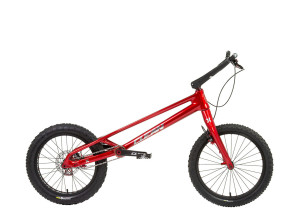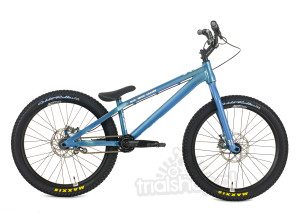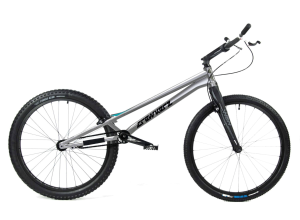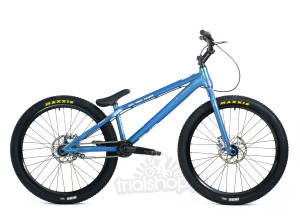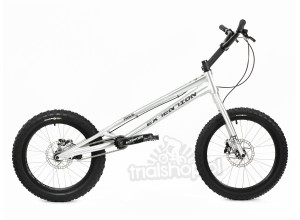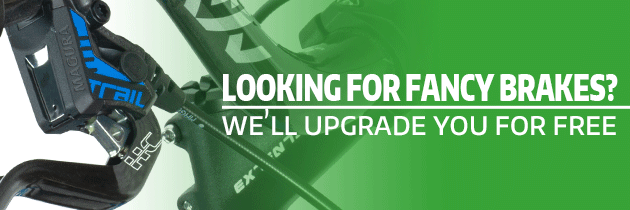Trials
Bike trials is a variant of mountain biking. It is practiced on specially adapted bikes with 20", 24", or 26" wheels, which most often than not do not have a saddle. By definition, trials riding involves overcoming various natural obstacles (such as rocks and logs) or artificial ones (walls, spools, railings, pallets) using the bike, without touching the obstacles with feet or other parts of the body. In practice, trials is a static, social, and spectacular sport that relies on perfect balance mastery and a range of techniques for jumping onto and over obstacles. In the 2020's trials has established itself as an athletic sport, with street-trials being the more recreational variant with a broader appeal.
Natural and urban are two types of obstacles used in trials. Natural involves riding on natural obstacles, characterized by complex shapes. It requires precision and high physical condition from the practitioner. Most experienced riders lean towards natural riding, which offers a significant challenge due to the complex shape of obstacles. Good natural terrain can be found in the mountains where riding on rocks is common. People in lowlands and cities often find interestingly configured stones in their areas, and occasional tree cutting offers an opportunity to ride on trunks. In some areas, specially adapted tracks called trials parks can be found, though these are still relatively uncommon. An alternative to natural obstacles is urban riding, which takes place on city obstacles such as walls and railings.
Bike trials originated from Spain, from motorcycle trials. Its precursor is Ot Pi, who as a child received a bike from his father on which he learned balance and the basics of motorcycle trials. Over time, Ot mastered the bike so well that he decided not to switch to a motorcycle. His passion infected many people, making him the father of this discipline.
Competitions in bike trials involve riding through established sections consisting of various obstacles within a set time, usually not exceeding 3 minutes. Competitions typically have several sections, each comprised of several gates - obstacles which riders need to clear. For clearing each gate, riders receive points. The rider with the highest number of points wins the competition.
Anyone can try their hand at this sport. You don't need a specialized bike to master the basics, although progress is much easier on one. A bike with the right specification is needed for full-fledged trials. The most important features of such a bike are strong brakes, a good freewheel, and a sturdy chain. These elements ensure the rider's safety, as these components withstand significant forces, and their failure can result in an accident.
In bike trials, three types of bikes are used, determined by wheel size:
- 26" (stock) - Named after a standard mountain bike. This name comes from the days when 26" trial bikes were very similar to regular mountain bikes.
- 24"- A niche filled by a few manufacturers. These bikes combine the features of 26" and 20". The way tricks are performed is similar to 26", but the bike itself is more agile. This is an uncommon wheel size found more frequently in recreational riding
- 20" (mod) - Named "mod" because it was a modified version of a bike specially adapted for trials. It featuers a 19" rear wheel whith the additional inch made up in tyre height for extra bounce. Disc brakes are commonly used on mod bikes.
Each wheel size has its advantages and disadvantages. 20" bikes require greater speed and are often chosen by shorter individuals. A characteristic jump for this wheel size is the bunnyhop. 26" bikes offer much more space for body movement. Many believe they perform better than 20" bikes, but maneuvering on tight obstacles is more challenging.
Beginners can start on a bike suited to their height. 20" kids' bikes - from 130cm. 20" bikes (with a thick rear tire) - from 150cm. 24" bikes - from 165cm, and 26" from 175cm. These are arbitrary intervals, and adults often choose wheel size according to personal preference.
Street-trials
This discipline strongly resembles trials from the noughties and nineties. Its divergence from trials happened after the premiere of Danny MacAskill's film, which quickly gained worldwide popularity. In the film, Danny defined this discipline and showed what can be done on a bike specially designed for it.
The discipline combines trials and street elements. Street is evident in tricks (various spins, tailspins) woven into trial elements - these are done quickly and fluidly, avoiding stops for more than a few seconds. Skateparks can be a good place to learn, but the most interesting obstacles are found in cities. In essence, street-trials is a discipline in which riders can have fun on the most basic obstacles, whereas trials usually requires challenging obstacles to be enjoyable.
In street-trial bikes, 24" wheels dominate. The bottom bracket on such bikes is relatively low and the head tube angle is sharp which in connection with 24" wheels, makes the bike agile and easy to rotate in a number of ways. Bikes with 26" wheels, which make it easier to perform trial evolutions on, are usually a choice for taller riders. 20" wheels are primaraly reserved for children, while 22" wheels are used by both youngsters and shorter adults, looking for a more playful bike. Street-trial bikes have a saddle, a high rise handlebar with relatively neutral grip, and a short stem with moderate rise. Disc brakes are the only type of brake used due to their modulation while the drivetrain can either be derived from trials bikes or from the wider biking market.









